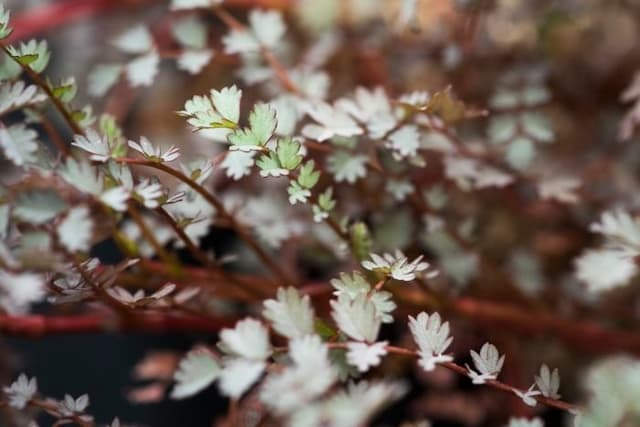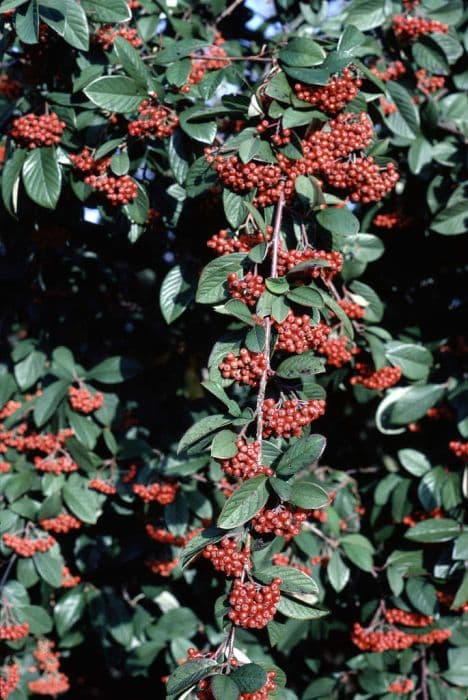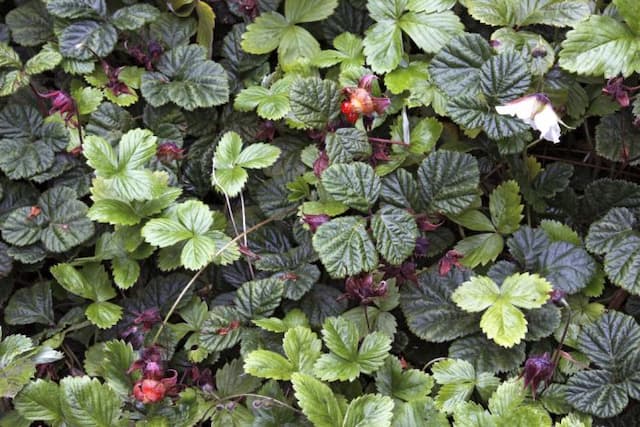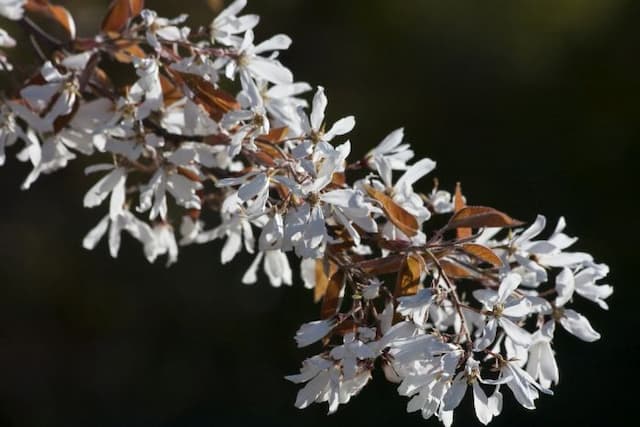Creeping Cinquefoil Potentilla reptans

ABOUT
The plant commonly known as creeping cinquefoil is adorned with five-petaled, bright yellow flowers that evoke a sunny disposition. These cheerful blossoms are each centered by a group of small, green sepals beneath them. The leaves of the creeping cinquefoil are distinctive in their own right; they are generally arranged in groups of five leaflets on a single stalk, giving them a palmate appearance reminiscent of an outstretched hand. The leaflets themselves are narrow with toothed edges, and their surface can be described as somewhat wrinkled, with a texture ranging between smooth and slightly hairy. Sending out long, thin runners across the ground, the plant exhibits a creeping habit, which allows it to cover ground efficiently, rooting at nodes as it goes. This roaming tendency enables the creeping cinquefoil to spread in a network-like fashion, forming a mat of green foliage interspersed with its golden flowers. The overall aesthetic of the creeping cinquefoil is that of a low-growing, spreading plant that is especially well-suited to gracing the fronts of borders, meadows, and even cracks in pavements, where it can survive minimal care and rougher conditions.
About this plant
 Names
NamesFamily
Rosaceae.
Synonyms
Creeping Cinquefoil, European Cinquefoil, Creeping Tormentil, Five Leaf, Five Fingers, Fünffingerkraut, Sinkfield.
Common names
Potentilla simplex Michx., Potentilla spathulata Lehm., Tormentilla reptans (L.) Crantz.
 Toxicity
ToxicityTo humans
Creeping cinquefoil (Potentilla reptans) is generally not considered toxic to humans. As with any plant, individual allergies or sensitivities can occur, but this plant does not typically pose a danger when touched or ingested. It does not have a reputation for being poisonous and there are no well-documented cases of poisoning from ingestion of this plant in humans.
To pets
Creeping cinquefoil is also not known to be toxic to pets. It is not listed on common toxic plant databases for animals such as cats and dogs. Similarly to humans, pets may have individual sensitivities, but there are no specific symptoms of poisoning associated with this plant, as it is not recognized for having poisonous properties to pets.
 Characteristics
CharacteristicsLife cycle
Perennials
Foliage type
Deciduous
Color of leaves
Green
Flower color
Yellow
Height
1 feet (30 cm)
Spread
2 feet (60 cm)
Plant type
Creeper
Hardiness zones
5
Native area
Europe
Benefits
 General Benefits
General Benefits- Ground cover - Potentilla reptans, commonly known as creeping cinquefoil, has a sprawling habit that can help cover bare spots in the landscape and provide a green carpet effect.
- Erosion control - The spreading nature and the root system of creeping cinquefoil help to anchor the soil, thereby reducing erosion on slopes and banks.
- Wildlife habitat - Creeping cinquefoil provides shelter and breeding grounds for various insects and small animals due to its dense foliage.
- Decorative uses - With its attractive yellow flowers and interesting leaf shape, creeping cinquefoil can be used in ornamental garden designs for visual appeal.
- Drought tolerance - Once established, creeping cinquefoil is known for its ability to withstand periods of low water, making it suitable for xeriscaping or drought-prone areas.
- Low maintenance - Requiring minimal care once established, creeping cinquefoil is an ideal plant for low-maintenance gardens and landscapes.
- Edible parts - Some parts of the plant are edible, such as the leaves and fruit, although they are not commonly consumed.
- Companion planting - Creeping cinquefoil can be used in companion planting due to its non-invasive nature, providing ground cover without competing strongly with other plants.
 Medical Properties
Medical Properties- Antidiarrheal: Potentilla reptans has been used traditionally to help alleviate diarrhea due to its astringent properties.
- Anti-inflammatory: It may possess anti-inflammatory effects, useful in treating conditions like sore throat or gum disease.
- Gastrointestinal aid: It has been used to improve digestion and treat various gastrointestinal issues.
- Wound healing: Topically applied, Potentilla reptans has been used in traditional medicine for its potential to promote wound healing.
- Antipyretic: The plant has been historically used to reduce fever due to its cooling effects.
 Air-purifying Qualities
Air-purifying QualitiesThis plant is not specifically known for air purifying qualities.
 Other Uses
Other Uses- Potentilla reptans, commonly known as creeping cinquefoil, can be used as a natural dye, yielding a range of colors from yellows to greens when used with different mordants.
- The leaves of creeping cinquefoil can be infused to create a mild astringent for use in homemade cosmetics or skin care applications.
- In the garden, creeping cinquefoil can serve as ground cover, suppressing weeds and helping to reduce soil erosion.
- The plant can be used in companion planting strategies, potentially deterring certain pests due to its specific scent and properties.
- Some artisans use the pressed or dried leaves and flowers of creeping cinquefoil in botanical papermaking for intricate designs and patterns.
- Due to its durability, creeping cinquefoil can be utilized in creating living walkways or lawn alternatives in landscaping.
- Creeping cinquefoil can be a food source for various butterfly and moth larvae, contributing to the ecosystem's diversity by supporting wildlife.
- The flowers are an attractive source of nectar and can be visited by bees and other pollinators, making it useful in pollinator-friendly gardens.
- In historical practices, creeping cinquefoil was sometimes used as a symbol in heraldry, representing five virtues: wisdom, knightly prowess, generosity, faith, and noble ancestry.
- As a bushcraft skill, the tough, fibrous roots of creeping cinquefoil have been used to make natural cordage for survival or primitive tool-making.
Interesting Facts
 Feng Shui
Feng ShuiThe Creeping Cinquefoil is not used in Feng Shui practice.
 Zodiac Sign Compitability
Zodiac Sign CompitabilityThe Creeping Cinquefoil is not used in astrology practice.
 Plant Symbolism
Plant Symbolism- Resourcefulness: Potentilla reptans, commonly known as creeping cinquefoil, often thrives in challenging conditions and symbolizes the ability to adapt and make the most out of any situation.
- Attraction: In some traditions, the five-petaled flowers of the creeping cinquefoil were believed to be powerful in love and attraction spells, symbolizing the drawing of positive connections.
- Protection: The pentagon shape of the leaves was historically associated with magical protection, making creeping cinquefoil a symbol of safeguarding against harm.
- Healing: With its medicinal properties, creeping cinquefoil is also a symbol of physical and spiritual healing, representing the restoration of balance and wellbeing.
- Persistence: As a plant that keeps growing and spreading despite being trodden on, creeping cinquefoil symbolizes resilience and the will to persist through challenges.
 Water
WaterCreeping cinquefoil should be watered deeply, allowing the soil to dry out slightly between waterings. Typically, this plant requires watering once a week with about one to two gallons of water, depending on the size of the plant and the weather. During hot or dry spells, watering frequency may increase, but be careful not to overwater as it can tolerate some drought. It's important to avoid waterlogging, which can cause root rot, so ensure the plant has well-draining soil and adjust watering accordingly during rainy periods.
 Light
LightCreeping cinquefoil thrives best in full sun to partial shade. Ideally, place the plant in a spot where it receives at least six hours of sunlight each day. If it's in too much shade, the plant may produce fewer flowers. However, in regions with very hot summers, some afternoon shade can be beneficial to protect the plant from scorching.
 Temperature
TemperatureCreeping cinquefoil is hardy and can withstand a wide range of temperatures, flourishing in conditions between 50 to 70 degrees Fahrenheit. It can survive winter chill down to about -30 degrees Fahrenheit but generally prefers cooler summers, not exceeding 85 degrees Fahrenheit. It's important to avoid extreme heat, as it can stress the plant.
 Pruning
PruningPruning creeping cinquefoil is important for maintaining its shape and encouraging healthy growth. Prune in late winter or early spring before new growth begins by removing dead or damaged stems and shaping as desired. Pruning can be done again after flowering to remove spent blooms, which may encourage a second flush of flowers. Generally, pruning once or twice a year is adequate.
 Cleaning
CleaningAs needed
 Soil
SoilCreeping cinquefoil prefers well-draining soil with a pH between 6.0 and 7.5. A balanced mix could comprise garden compost, loamy soil, and sand to ensure good drainage and aeration. Mulching helps retain moisture and regulate soil temperature.
 Repotting
RepottingCreeping cinquefoil does not often require repotting as it spreads through runners. It's best to assess the plant every 2 to 3 years and repot if it becomes root-bound or the soil quality degrades.
 Humidity & Misting
Humidity & MistingCreeping cinquefoil is not particularly humidity-sensitive and can tolerate a wide range of humidity levels. It performs best in outdoor environments where the humidity is naturally regulated.
 Suitable locations
Suitable locationsIndoor
Place in bright light, water moderately.
Outdoor
Full sun to part shade, moist, well-drained soil.
Hardiness zone
4-9 USDA
 Life cycle
Life cycleCreeping cinquefoil (Potentilla reptans) begins its life cycle as a seed, which germinates in spring when conditions of moisture and temperature are favorable. Following germination, the seedling emerges, develops its first true leaves, and establishes a small root system. As the plant matures, it develops a rosette of leaves and sends out long, slender runners (stolons) that touch the ground and can root at the nodes, forming new plants, demonstrating a vegetative propagation stage. Throughout the growing season, typically from June to September, the creeping cinquefoil produces yellow, five-petaled flowers, which after pollination by insects, develop into fruits containing seeds. These seeds can then be dispersed by various means, including animals and water, to begin a new cycle. In winter, the above-ground parts of the plant may die back, but the perennial root system allows the creeping cinquefoil to survive and regrow the following spring.
 Propogation
PropogationPropogation time
Spring-early summer
The most popular method of propagation for Creeping Cinquefoil (Potentilla reptans) is by separating its runners. This perennial herbaceous plant naturally produces long, creeping stems that take root at intervals, forming new plants. Propagation is best done in the spring or early autumn when the plant is actively growing. To propagate, identify a runner with well-developed roots, gently detach it from the parent plant, and plant it in well-drained soil at the same depth it was growing previously. Ensure the soil remains moist until the new plant is established. This method is simple and effective, quickly increasing the number of plants in your garden.









